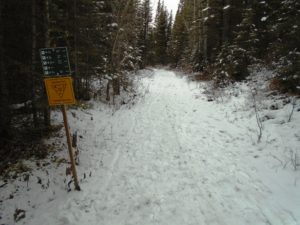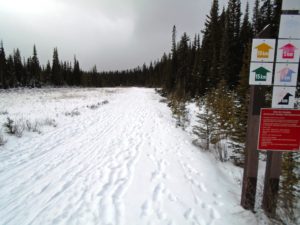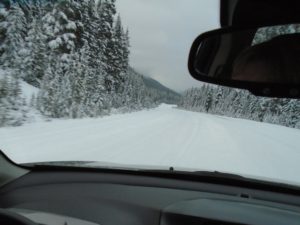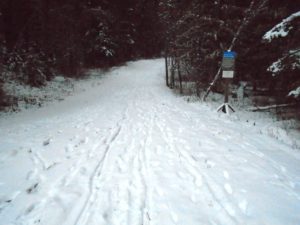The following is an update from the CNC:
Due to the Alberta Cup this weekend, Frozen Thunder will be closed
- Friday: 12 pm – 4 pm
- Saturday and Sunday: 8 am until 4:30 pm.
Warm fall temperatures have been challenging for snow making, and mother nature is not cooperating with our winter season. Trails in the Stadium area will be available with very limited terrain.
Thank you for your understanding and patience as we anticipate colder temperatures soon. Please do your snow dance!
******
Scouting
We took a drive down the Smith-Dorrien this afternoon and checked out a few ski trails.
Goat Creek
The trail has 1-2 cm of snow but it is definitely not skiable. Lots of exposed gravel and rocks. The Smith-Dorrien road is still mostly bare for the first 15K south of Canmore. Temperature was -1°C.
Mt Shark
As we drove south, the road finally became snow-covered near Sparrowhawk and much nicer to drive on. At the Rummel Lake trailhead I could see a well-packed snow-covered trail from the road.
The road to Mt Shark ski area is very snow-covered but still easy enough to navigate. The Mt Shark trails have a thin snow cover with occasional exposed rocks. Not deep enough for grooming. The snow has been packed down by skiers, fat bikes, and hikers. It looked skiable but you’d have to be desperate. It was snowing lightly and the temperature was -2. There is 10-15 cm of new snow predicted over the next three days.
Pocaterra
Heading south, it was snowing heavier around Chester Lake with some accumulation on the road. Pocaterra had about the same amount of snow as Mt Shark which is surprising, but it wasn’t as packed down. It’s been walked on, but I didn’t see any skier tracks. It was trying to snow. Temperature was -2. The hut is now open.
We didn’t get down to Elk Pass, but I’m hoping some of that higher elevation snowfall was finding its way there. There is 5-10 cm of new snow predicted for this area over the next three days.







I’m not saying that all of the HRT should be designed with skiers in mind, but the thing is- the trail to Rummel has long been popular with skiers, predating the snowshoe and fat bike booms by decades. To deliberately add hazards to an established ski route is just plain stupid!
Do you think it might have something to do with Parks not recognizing the trail as an official trail? Not having seen it first hand would an early snow pack like we had at this time last year be the difference? Jonathan, I don’t really buy into user groups thinking they have preference on the trails, we should be able to get along with a little courtesy.
Rummel Lk
Just a warning to follow up on your observation of snow on the Rummel Lake trail. The portion of the Rummel Lake trail from the road up to the High Rockies Trail junction was “upgraded” this summer, as part of the High Rockies Trail. More accurately, the trail was ruined for winter ski use. Just like other parts of the High Rockies Trail, this trail was “upgraded” to be a summer mountain bike trail. Rocks, logs, dirt piles and other debris were intentionally placed across the formerly ski-able trail to turn it into an narrow, bermed single-track mountain bike trail. Absolutely no thought was given to winter users, like skiers or snowshoers. Not a single consideration was given to skier safety. Many of the hazards are placed in the middle of hills and corners. The trail has been narrowed so that snowplowing to control speed is impossible. As a result, the trail is littered with potential accident sites. Since these dangers were intentionally created, I believe it opens Alberta Parks to the potential for a lawsuit, in the event of injuries.
The Trans-Canada Trails folks should be ashamed of themselves for destroying winter trail use opportunities in a part of the country that is typically snow covered for 7 months of the year.
It will take a pretty significant snow depth to make this trail skiable!
I took a few photos and then gave up and went home in disgust.
https://goo.gl/photos/pZctqYvNgZt5vjcm6
Re:Rummel: It seems like there is no oversight on this project, or the oversight has no concept of what makes for a safe and enjoyable ski trail.
Which doesn’t make sense for what is touted as a multi use year round trail, especially in the Smith Dorrien where it will be snow covered for the bulk of the year (hopefully!).
Who can we contact with concerns about this? Given the shallow snowpack and that there are machines working on the TCT trail further south- it may not be too late to remedy the situation. That would wreck any snow base on the Rummel trail right now, but short term pain for long term gain.
How long is this section?
The portion that has been “upgraded” as High Rockies Trail access or is shared by the HRT is about 2 km. As far as I know, no damage has been done to the trail beyond that point.
I’m awestruck that in the year 2016 the Alberta Parks people aren’t consulting more with some of the area’s ski pioneers like Alf, so that newly designed trails can be safely used in all seasons. I would have thought that by now, the Parks staff would have been filled with ex-grads of the Outdoor Program, and would all know about the importance of winter trail usage.
It’s a good point that there are more months of snow in that area than not.
I wonder if this is a result trying to develop separate trail systems for each type of user. There are some skiers who don’t seem to want to share the trails with other users which is fine, but you’ll probably have to accept that skiing will not be accommodated on some of the bike trails. I believe that bikes are not permitted on the HRT in PLPP so it isn’t totally unreasonable that there are other sections where skiing isn’t possible.
This appears to be a case of someone designing a trail without ever reading the Peter Lougheed/Spray Valley Provincial Parks Management Plan. Rummel Lake is currently an official winter (ski/snowshoe) trail that leads to the only official backcountry winter campsite in Kananaskis Country. The Management says that the trail will also be upgraded as a summer trail.
It is very possible to design a sustainable summer trail, with good drainage and reasonable grades that also functions well as a winter ski/snowshoe/fat bike trail. Because this is an access trail to the High Rockies Trail, it needs to accommodate all anticipated users, not reduce the number of users to just one or two activities. And any trail “upgrade” should not introduce hazards that did not exist on the original trail.
It is certainly understandable that different sections of the High Rockies Trail be designed for different users. The portions between Goat Creek and Buller Mountain typically get low snowfalls and are perfect for hiking, biking and snowshoeing. The section that crosses the Buller Mountain avalanche paths is unsafe for winter use, so it is logical that it only designed for summer use. The segment between Buller Creek and Rummel Creek is a transition zone that gets less snow along the west end and more snow closer to Rummel Creek. It seems reasonable to design it for summer and limited winter use, like snowshoeing or fat biking. The part from Rummel Lake trail to Chester Lake trail has enough snowfall to be good for skiing, but the terrain is too steep to allow for construction of a ski-specific trail. However, this section starts by crossing a traditional ski/snowshoe trail and ends on a designated ski trail… so the needs of skiers and snowshoers should have been considered, when designing the access trail.
We can all get along, as long as the trail design and construction considers all the users who are expected to be on it.